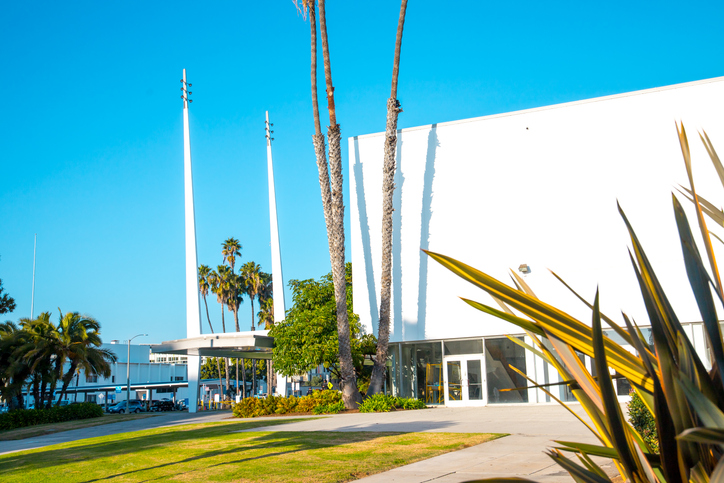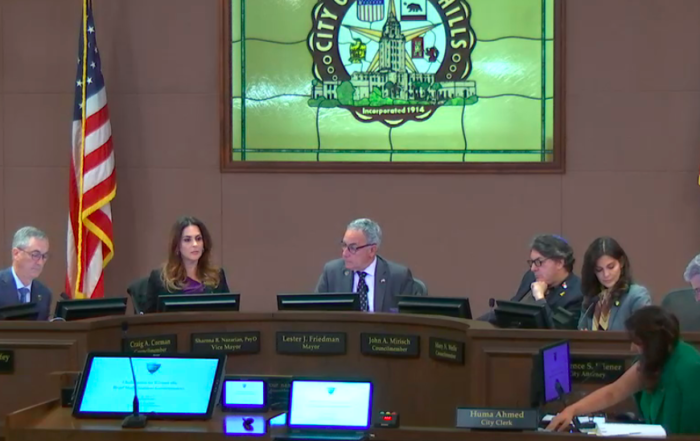It’s been more than 10 years since the Santa Monica Civic Auditorium closed for business. And even in its last years of operation, the venue didn’t seem to attract much more than a string of cat shows. Nothing against cats, but this is a venue that its biggest fans constantly remind us once hosted the Academy Awards (a really long time ago).
Currently, the NIMBY no-growth group Santa Monica Coalition for a Livable City (SMCLC) is leading a charge to save the Civic Auditorium and is spreading misinformation and conspiracies about city staff somehow trying to scuttle the property. This is a group, mind you, that thinks Santa Monica should be a finished product and is against building anything new outside of perhaps a garden tool shed.
SMCLC’s battle cry surrounds a throwback to the early 1980s when local residents nobly activated to save the iconic Santa Monica Pier, which was in real danger of being razed to make room for a bizarre man-made island development. They want to do the same for the Civic and constantly compare the two properties.
We’re here to tell you, friends, the Santa Monica Civic Auditorium is NO Santa Monica Pier. When was the last time family or friends came to visit and said, “Hey, will you take us to go see your magical Civic Auditorium?” Whereas the Pier regularly rates as one of the top five most visited places by tourists visiting L.A. and Orange Counties. How many movies or TV shows have shown transitional shots or used the Civic Auditorium to give you an iconic sense of place? No, it is indeed the Pier that is used for such media purposes and informs audiences of exactly where they are.
We would like to clarify a few things going on with regard to the Civic Auditorium, a venue that you can obviously tell we find mediocre at best, and – as a matter of historical fact – was constructed as part of a racist effort to displace the largely Black Belmar Triangle Neighborhood in the 1950s. It was also built in a time well before The Broad Stage or even the impressively improved John Adams Middle School Auditorium had come into existence.
The Realities of Keeping the Civic Open
First, what happened? About 15 years ago, safety concerns were raised that “the Civic” was not seismically sound, and would require millions of dollars in seismic retrofit and Americans with Disabilities Act (ADA) upgrades to remain an operable venue. In 2009 dollars, $51.9 Million from the City’s Redevelopment Agency was set aside to make such repairs and make the Civic whole for event use. However, before that work could take place, then former-but-new-again Governor Jerry Brown disbanded redevelopment agencies and took the money to reduce the state’s large debt and overall restructure state finances.
Of course, today the required fixes to re-open the Civic are estimated at closer to $100 Million. And yet SMCLC continues to insist that the city save the Civic. But the city can’t afford to simply fix up the civic on its own, so why should it be expected to do so without a winning partnership that would guarantee attractive events?
There also existed, of course, the large expense to the city itself to keep the Civic open. In fact, basic operations and maintenance costs would have been estimated at about $200,000 a year to the city. This was of course much easier to afford prior to the construction of the Belmar Park Soccer Field, when the lot enjoyed more than 800 parking spaces that could generate significant parking revenue to help finance maintenance and operations.
During these dormant years, the city has made two considerable efforts to enter agreements with commercial event specialty companies to renovate and take over operations of the Civic: The first with the Nederlander Concert organization, and later through an RFP process with the Oak View Group led by former L.A. public fixture Tim Leiweke. Both efforts didn’t pan out as feasible, and in the end, no Exclusive Negotiating Agreement (ENA) could be reached with Oak View.
Making matters more difficult for bidding parties is that throughout this period, there were already designs on the Belmar Park soccer and athletic field we enjoy today. This limited parking options for whatever operator would have taken over the Civic. And parking in the coastal zone is governed by the Coastal Commission, an organization known for requiring significant parking be made available for any operators planning on doing business in the coastal zone. So where would these event venue professionals find enough parking for events? Chances are, they would have had to construct a significant structure somewhere nearby, adding to the considerable expense of taking on the Civic and its tens of millions in seismic and ADA upgrades.
In addition, given the Civic’s status as a historic site, any changes an operator would like to make to the building would need an approved Certificate of Appropriateness. A Certificate of Appropriateness requires any changes to a historic property to meet something close to the original purpose or to remain relatively consistent with the original building in some way. Enough to scare away interested parties? All evidence says no, but certainly another expense with time delays to consider.
The Surplus Lands Act is Real
One might ask, “What are the city’s options?” Well, they are severely restricted by a state law called the Surplus Lands Act (SLA), which is essentially a pro-housing piece of legislation. The State’s Department of Housing and Community Development says, “SLA is a ‘right of first refusal’ law that requires all local agencies to offer surplus land for sale or lease to affordable home developers and certain other entities before selling or leasing the land to any other individual or entity.” This required Santa Monica to place a public “Notice of Availability” (NOA) forward for interested parties to see that the Civic land was surplus property. And, of course, it attracted interest.
When a public property is in negotiation, that process happens in closed session. Why? Well, in part, to protect the public from its representatives giving up their entire strategy publicly to the potential buyer. Can you imagine the city council having to show its cards to an interested party meeting after meeting in public until the city had no leverage left to get a good deal for the property?
SMCLC would have you believe a couple of things in relation to these items. First, they seem to think the SLA is a casual suggestion that can be waived aside. It’s not. It’s the law. Second, they seem to believe that the negotiations being in closed session is a nefarious, staff-driven agenda meant to control the city council and to keep the public away so they can give up the farm. That is simply not true. Once the city does find a party with which an ENA can be entered, then an active public hearing process would go into play where the public would have more than ample opportunity to weigh in. And any new project on the land would require an environmental impact report (EIR), the process surrounding which would give the public even more opportunity to weigh in.
In response to the SLA, two interested parties have come into play. The first was a partnership between nonprofit housing provider Community Corporation of Santa Monica and Metropolitan Pacific Real Estate Group. They wanted to revive the Civic and add affordable housing surrounding the property. But that effort didn’t pan out. The city is now entertaining interest from the Santa Monica-Malibu Unified School District, which is expected to put a proposal forward after Labor Day that may involve something revolving around education, recreation, and/or open space – all of which are also allowed under the SLA.
The City Council, Not the Staff, Is in Charge
As far as we know, no one on staff or the city council is clamoring to raze the Civic. In fact, through several iterations of the city council now, the direction has consistently been to try and revive and save the Civic. And it is, in fact, city council’s direction that will decide what happens. City Staff is not in charge – they simply have to follow laws like the SLA and help the council keep a process moving forward. There really is no actual evidence of some crazy anti-Civic agenda.
Hell, we don’t even have an “anti-Civic” agenda. In fact – to be clear — we’re not against saving the Civic and rejuvenating it into a lively and dynamic venue. We’re just not huge fans of the place and downright resent the false equivalency to the Pier being made by SMCLC.
Moving forward, like all Santa Monicans and many other Westsiders, we will continue to monitor developments with great interest. But we implore the public to do so honestly and in recognition of certain realities facing the effort. Saving the civic will be an extraordinarily expensive affair, require a savvy partnership that can attract household-name level talent and events, and follow a very clear public process that isn’t an overnight “campaign” of mere sentimental goodwill.
Photo by LMWH
Stay informed. Sign up for The Westside Voice Newsletter
By clicking submit, you agree to share your email address with Westside Voice. We do not sell or share your information with anyone.








